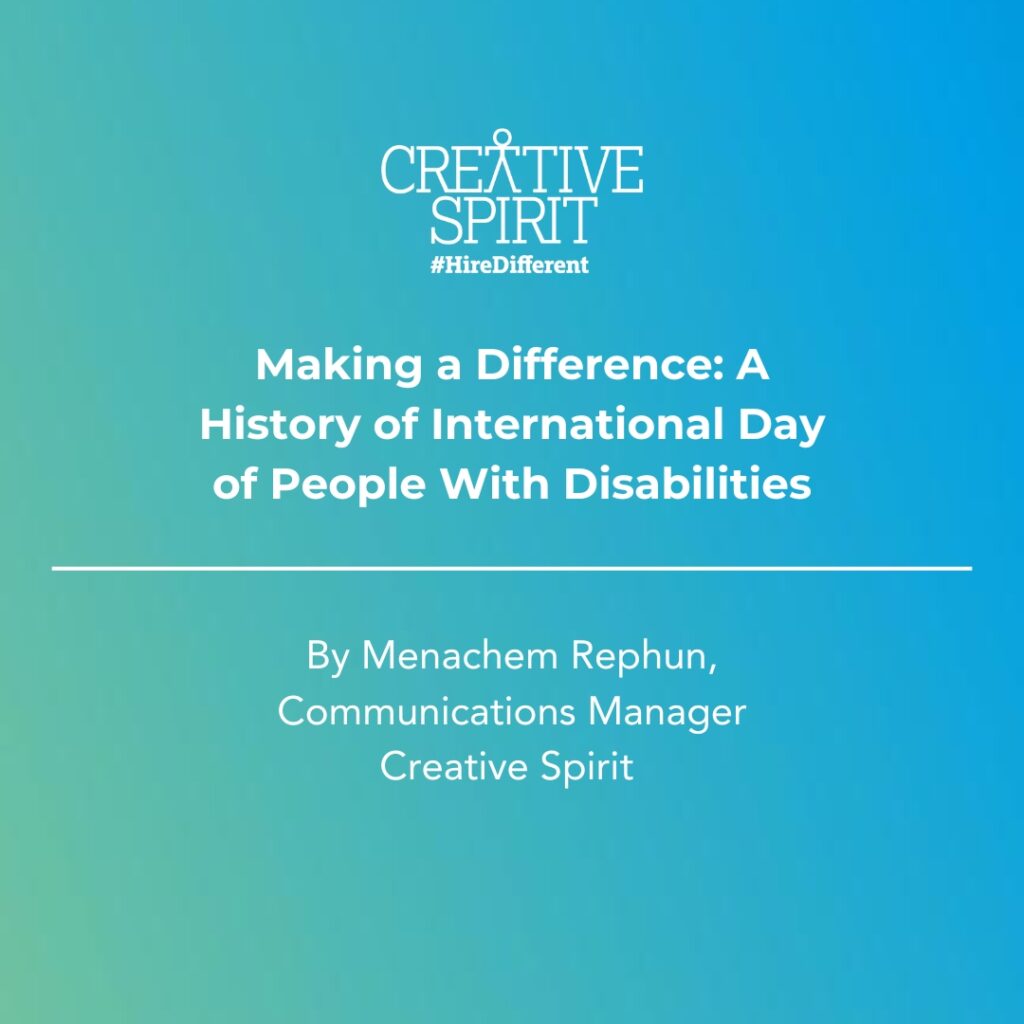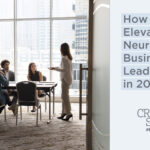By Menachem Rephun, Communications Manager & Advocate, Creative Spirit

Disabled/Neurodivergent/People With Disabilities and IDPWD
44.1 million, or 13.4% of the population: that’s how many Americans have a disability/disabilities, according to the 2024 American Community Survey (ACS). Meanwhile, 15-20% of people are estimated to be neurodivergent (Nancy Doyle), equaling more than 1 billion people worldwide. Despite comprising such a large demographic, disabled/neurodiverse/people with disabilities face considerable disparities in healthcare, employment, and education. One notable, ongoing effort to counteract this is the International Day of People With Disabilities (IDPWD).
Held annually on Dec. 3, IDPWD highlights the strengths of disabled/neurodiverse/people with disabilities, and raises awareness of crucial disability rights issues. Of course, the focus isn’t simply on raising awareness, but on developing solutions that can make a difference. Part of achieving that impact involves elevating disabled people to leadership roles and leaning into valuable expertise in decisions and discussions that affect their lives.
That’s why the IDPWD theme for 2024 is “amplifying the leadership of persons with disabilities for an inclusive and sustainable future”.
In the words of Sam O’Donovan, Chief People Officer of AXA Global Healthcare: “Neurodivergent leaders bring fresh perspectives and ideas, pattern recognition abilities, and see connections between things that others often don’t, making them fantastic problem solvers. Also, they can think critically and abstractly, challenge norms, and offer valuable input to strategy development.”
Creating those leadership opportunities, and encouraging businesses to appreciate them, is a goal that resonates deeply for us at Creative Spirit. Achieving full representation for people with disabilities and giving them a seat at the table is crucial to our mission. It’s an effort we believe all advocates and supporters of the neurodiverse community can and should be a part of. In this article, we’ll explore the background and history of IDPWD, and how it intersects with the current disability rights/neurodiversity movement. We’ll also focus on how workplace cultures can change so that neurodiverse individuals and others with disabilities have a place in executive/leadership positions, and equal opportunities to succeed.
International Day of Persons With Disabilities: How Did It Start?
IDPWD began on Dec. 3, 1992, when it was proclaimed as an annual observance by the United Nations General Assembly Resolution 47/3. The primary focus of the day involves enabling disabled/neurodiverse/people with disabilities to participate in all aspects of life without discrimination or prejudice. This mission is more important than ever at a time when discrimination is still very much a problem for disabled/neurodiverse people around the world, especially in employment.
According to the U.S. Department of Labor, the unemployment rate for people with disabilities in 2023 was 7%, which is about twice the rate for people without disabilities (3.5%). IDPWD serves as a reminder that while these problems might seem daunting, history has shown that they can be overcome through direct action and concerted, strategic effort.
Over the past few decades, disability rights activists have changed society through civil disobedience and demonstrations, culminating in the landmark Americans With Disabilities Act (ADA) of 1990. Activists like Judy Heumann, Ed Roberts, Sandra Swift Parrino, and many others bravely and successfully defied an establishment stacked against disabled/neurodiverse/people with disabilities. Through their efforts, millions of Americans now have greater opportunities in employment and education, accessibility to public transportation, and much more. While discrimination still exists, these exceptional individuals’ efforts created a step forward.
Through the ADA, physical accessibility in offices, schools, and public transportation has significantly improved, and disabled/neurodiverse/people with disabilities have legal protections against workplace discrimination that did not previously exist. The neurodiversity movement, also led by grassroots activism, has motivated companies like Voya, Havas, INVNT, Google, Microsoft, Verizon, and many others to actively include employees with autism, ADHD, dyslexia, and other conditions in their workforce. IDPWD spotlights this progress while emphasizing the areas still needing improvement.
Incorporating IDPWD Theme’s Into Hiring Practice
For employers, there are numerous ways to observe IDPWD in the workplace. Some recommendations from ChangeEngine.com include educating yourself about disabilities, providing accessibility options for employees and customers, and celebrating success stories from people with disabilities.
As ChangeEngine points out, education about disabilities/neurodiversity – physical, mental, emotional, or social – is crucial to making workplaces more inclusive.
Through that education, employers can better understand how to support neurodiverse employees, and develop best practices for getting there. Creative Spirit offers a comprehensive #HireDifferent training package designed to do just that. Through that program, we equip employers with the tools, skills, and resources to onboard neurodiverse employees and provide reasonable accessibility options and accommodations.
We also agree with ChangeEngine’s recommendation that employers observe IDPWD by celebrating and sharing the experiences and stories of disabled/neurodivergent/PWD in your organization. This communicates insights that inform others to grow. That being said, some neurodiverse employees (or those with physical disabilities) prefer not to be singled out or seen as exceptional simply for having a diagnosis, and that should be understood and respected.
ChangeEngine emphasizes the importance of “Ask, Don’t Assume”. In other words, if an employer or co-worker is unsure how to support a co-worker, it’s preferable to ask, rather than make assumptions. As ChangeEngine explains, “Not everyone with a disability needs or wants help, and the type of [support] needed may differ from person to person.”
Recognizing the individuality of neurodiverse employees and seeing the person before the disability are essential steps employers can take toward making workplaces more accessible and supportive.
The Role of IDPWD In Breaking Down Myths and Misconceptions
There are still prevailing myths among businesses that accommodating employees with disabilities is too expensive. Part of IDPWD involves rebutting those misconceptions and making employers aware that reasonable accommodations can be provided at low cost and effort.
According to studies from the Job Accommodation Network (JAN), 49.4% of accommodations cost nothing, while others cost as little as $300 (Thinkability). IDPWD also encourages employers to recognize that employees with disabilities/neurodiversity are hard-working, talented, capable, and dependable.
As ThinkabilityWisconsin.org explains, “Studies have shown that employees with disabilities make reliable, dedicated employees. They have lower turnover, require similar levels of supervision, and identical job performance ratings compared to people without disabilities in similar positions.” As more employers start to recognize this and disability is destigmatized, people with disabilities/neurodiversity will have more significant opportunities to succeed in employment and leadership roles.
How Employers Can Be More Supportive
In a blog post for CapacityMedia.com, neurodiverse self-advocate and technology expert Cybill Watkins breaks down other myths and misconceptions about neurodiversity, and shares how employers can be more supportive.
“Perhaps the biggest misconception is that neurodivergent people are ‘all alike’”, she writes. “Just as no two people are the same, neither are any two neurodivergent people – and that includes those with the same diagnosis. Our needs and expectations are entirely unique and not only that, they can evolve over time.” Cybill Watkins, Neurodiverse Self-Advocate and Technology Leader
Watkins explains that the responsibility is shared between employees, managers, and HR leaders to ask what they need, not just once but as an ongoing dialogue. She adds that another common myth is that employees must be diagnosed to ask for reasonable accommodations.
“Something that many people still don’t know is that an employee does not need a formal diagnosis to ask for reasonable adjustments,” she writes. “Given that diagnosis can also take years, employers should be offering, and making, adjustments throughout the employee’s lifecycle as traits appear and as they require additional support.” Cybill Watkins, Neurodiverse Self-Advocate and Technology Leader
One of the most important areas where IDPWD can make a difference is in driving home that people with disabilities/neurodiversity are not a small or niche demographic. As Auticon.com points out, many employers are unaware that 15-20% of the population is neurodivergent. Even many employees might be unaware that they’re neurodivergent, due to biases in diagnostic tools that have led to women, Asians, Black, and Hispanic people being underdiagnosed.
“Neurodivergent employees are not a niche, small, or uniform group,” Auticon.com writes, “with a wide range of backgrounds, skills, challenges, and needs. Creating a neuroinclusive workplace benefits all neurodivergent employees, whether or not they have a formal diagnosis or choose to disclose it.”
Recognizing that people with disabilities/neurodiversity are not a niche demographic is an essential step towards destigmatizing disability, and preventing people with disabilities from being marginalized and excluded.
“Othering” Is Detrimental To Everyone
This Dec. 3 marks over 30 years since the first IDPWD. This year and every year, IDPWD should be more than just another event to mark off the calendar. On the contrary, it’s a day that shouldn’t come and go without serious reflection on the challenges and inequities still faced by millions of people with disabilities, especially in employment. Above all, IDPWD is a powerful reminder that “othering” people with disabilities is detrimental to everyone and that, conversely, inclusion and understanding benefit all of us. Disabled/Neurodiverse/PWD are not an “other”: they are us.
This is especially true given that, statistically, almost everyone will experience some form of disability at some point in their lives. Decades of courageous activism and advocacy have made inroads, but there’s still so much left to accomplish. Whether as co-workers, employers, family members, or friends, it’s incumbent on all of us to build the change we want to see. IDPWD offers an opportunity to be a part of that change. It conveys a message of hope, encouragement, and optimism that we can create a world where discrimination is a thing of the past, and finding a fair-wage job is not a huge obstacle to overcome for neurodivergent people. In the words of Sam O’Donovan, “The companies that will lead tomorrow are the ones celebrating neurodiversity today.” Heading into 2025, we have the wherewithal and resources to help build workplaces where people with disabilities are not only comfortable with disclosing, but have more significant opportunities to succeed in leadership roles. That’s always been the dream: this IDPWD, let’s make it a reality.
Sources:
1. https://www.census.gov/newsroom/facts-for-features/2024/disabilities-act.html
2. https://www.bls.gov/news.release/pdf/disabl.pdf
3. https://library.changeengine.com/moments/international-day-of-persons-with-disabilities-all-employees#:~:text=International%20Day%20of%20Persons%20with%20Disabilities%20was%20created%20in%201992,disability%20issues%20throughout%20the%20world
4. https://www.capacitymedia.com/article/2cwymj1pf4bo3kwvuo9hc/industry-voices/neurodiversity-at-work-busting-the-myths-and-misconceptions
5. https://blog.auticon.com/debunking-myths-about-workplace-neurodiversity/






